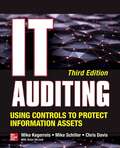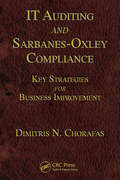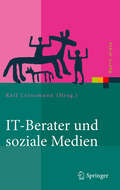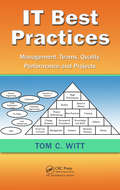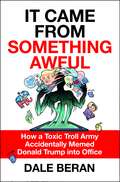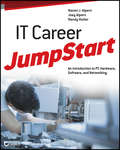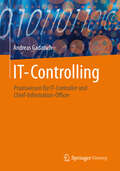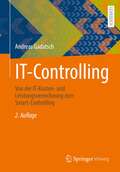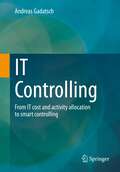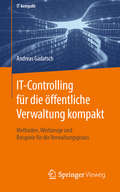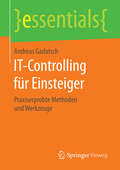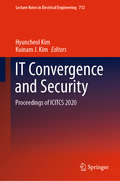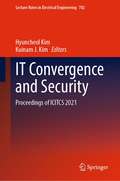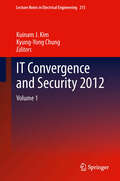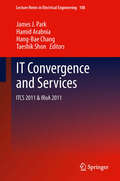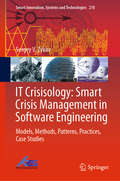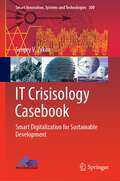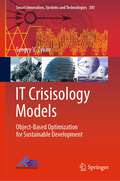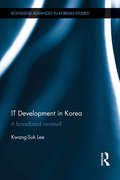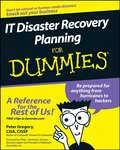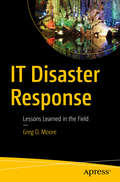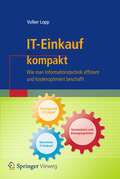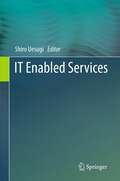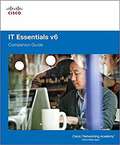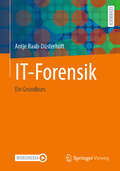- Table View
- List View
IT Auditing: Using Controls to Protect Information Assets
by Mike Kegerreis Mike Schiller Chris DavisSecure Your Systems Using the Latest IT Auditing Techniques <p><p>Fully updated to cover leading-edge tools and technologies, IT Auditing: Using Controls to Protect Information Assets, Third Edition, explains, step by step, how to implement a successful, enterprise-wide IT audit program. New chapters on auditing cybersecurity programs, big data and data repositories, and new technologies are included. This comprehensive guide describes how to assemble an effective IT audit team and maximize the value of the IT audit function. In-depth details on performing specific audits are accompanied by real-world examples, ready-to-use checklists, and valuable templates. Standards, frameworks, regulations, and risk management techniques are also covered in this definitive resource.
IT Auditing and Sarbanes-Oxley Compliance: Key Strategies for Business Improvement
by Dimitris N. ChorafasInformation technology auditing and Sarbanes-Oxley compliance have several overlapping characteristics. They both require ethical accounting practices, focused auditing activities, a functioning system of internal control, and a close watch by the board's audit committee and CEO. Written as a contribution to the accounting and auditing professions
IT-Berater und soziale Medien
by Ralf LeinemannIT-Produkte sind häufig sehr komplex. Daher spielen Berater bei Kaufentscheidungen eine wichtige Rolle. In dem Band setzen sich die Autoren mit dieser Situation auseinander und befassen sich mit ihren Auswirkungen auf Kommunikationsabteilungen von Unternehmen. Sie gehen auch auf die wachsende Bedeutung von Social Media und den damit einhergehenden Veränderungen der Beraterlandschaft ein. Zudem werden regionale Besonderheiten bzw. die Situation in Deutschland im internationalen Kontext betrachtet.
IT Best Practices: Management, Teams, Quality, Performance, and Projects
by Tom C. WittConsistent success does not happen by chance. It occurs by having an understanding of what is happening in the environment and then having the skills to execute the necessary changes. Ideal for project, IT, and systems development managers, IT Best Practices: Management, Teams, Quality, Performance, and Projects details the skills, knowledge, and a
It Came from Something Awful: How a Toxic Troll Army Accidentally Memed Donald Trump into Office
by Dale BeranAn insider's history of the website at the end of the world, which burst into politics and memed Donald Trump into the White House.The internet has transformed the ways we think and act, and by consequence, our politics. The most impactful recent political movements on the far left and right started with massive online collectives of teenagers. Strangely, both movements began on the same website: an anime imageboard called 4chan.org. It Came from Something Awful is the fascinating and bizarre story of 4chan and its profound effect on youth counterculture.Dale Beran has observed the website's shifting activities and interests since the beginning. 4chan is a microcosm of the internet itself—simultaneously at the vanguard of contemporary culture, politics, comedy and language, and a new low for all of the above. It was the original meme machine, mostly frequented by socially awkward and disenfranchised young men in search of a place to be alone together.During the recession of the late 2000’s, the memes became political. 4chan was the online hub of a leftist hacker collective known as Anonymous and a prominent supporter of the Occupy Wall Street movement. But within a few short years, the site’s ideology spun on its axis; it became the birthplace and breeding ground of the alt-right. In It Came from Something Awful, Beran uses his insider’s knowledge and natural storytelling ability to chronicle 4chan's strange journey from creating rage-comics to inciting riots to—according to some—memeing Donald Trump into the White House.
It Career JumpStart
by Naomi J. Alpern Joey Alpern Randy MuellerA practical approach for anyone looking to enter the IT workforce Before candidates can begin to prepare for any kind of certification, they need a basic understanding of the various hardware and software components used in a computer network. Aimed at aspiring IT professionals, this invaluable book strips down a network to its bare basics, and discusses this complex topic in a clear and concise manner so that IT beginners can confidently gain an understanding of fundamental IT concepts. In addition, a base knowledge has been established so that more advanced topics and technologies can be learned over time. Includes a discussion of the key computer components, such as the processor and memory Covers the basics of data storage as well as the input/output process Zeroes in on basic hardware configuration including how to install hardware and software drivers Introduces various computer operating systems, including the Windows OS family, Linux, and Mac. Looks at basic networking concepts and design IT Career JumpStart is an ideal starting point for anyone looking for a career in IT but doesn't know where to start.
IT-Controlling
by Andreas GadatschViele Unternehmen planen dem zunehmenden Kosten- und Leistungsdruck in der IT etwas entgegenzusetzen. Das IT-Controlling-Konzept liefert hierzu die passenden Methoden. Das Buch erklärt in kompakter Form, welche strategischen und operativen Instrumente für den IT-Controller entwickelt wurden und wie sie in der Praxis eingesetzt werden können. Der Buchmarkt für das Spezialgebiet IT-Controlling ist begrenzt. Die Bücher des Autoren "Gadatsch" gelten als Standardwerke. Das kompakte Buch "IT-Controlling realisieren" ergänzt das vom Autor mit herausgegebene Lehrbuch "Masterkurs IT-Controlling", das sich an Studierende und Wissenschaftler richtet. Es verzichtet weitgehend auf theoretische Ableitungen und "zeigt wie es geht".
IT-Controlling: Von der IT-Kosten- und Leistungsverrechnung zum Smart-Controlling
by Andreas GadatschIT-Controlling ist als Instrument zur Steuerung der Informationstechnik etabliert. Das Berufsbild des IT-Controllers bzw. der IT-Controllerin hat sich über längere Zeit nur moderat verändert. Es wurde vor allem mit IT-Budgetierung, IT-Portfoliomanagement, IT-Kostenplanung, -Verrechnung und -kontrolle in Verbindung gebracht. Durch die Digitalisierung ist jedoch Bewegung in Ziele, Inhalte und Methoden gekommen. Neue Themen wie Steuerung der Digitalstrategie, Cloud-Controlling, Data Science u. a. sind in der Diskussion. Das Aufgabenprofil wandelt sich weg von der reinen IT-Kostenanalyse, hin zum Management der Digitalisierungsstrategie mit einem Fokus auf strategisches IT-Portfoliomanagement. Einige Stimmen sprechen bereits vom „Smart-Controlling“ oder „Digital-Controlling“. Das Buch stellt ein IT-Controlling-Konzept für das Digitale Zeitalter vor und erläutert die relevanten Methoden in praxisnaher Form.
IT Controlling: From IT cost and activity allocation to smart controlling
by Andreas GadatschIT controlling is established as a tool for controlling information technology. The job description of the IT controller has changed only moderately over a long period of time. It was mainly associated with IT budgeting, IT portfolio management, IT cost planning, accounting and controlling. However, digitalization has brought movement in goals, contents and methods. New topics such as digital strategy management, cloud controlling, data science, etc. are being discussed. The task profile is changing away from pure IT cost analysis to the management of the digitization strategy with a focus on strategic IT portfolio management. Some voices are already talking about "smart controlling" or "digital controlling". This book presents an IT controlling concept for the digital age and explains the relevant methods in a practical way.
IT-Controlling für die öffentliche Verwaltung kompakt: Methoden, Werkzeuge und Beispiele für die Verwaltungspraxis (IT kompakt)
by Andreas GadatschAndreas Gadatsch zeigt konkret auf, was IT-Controlling ist und wie man es in der öffentlichen Verwaltung nutzen kann. Hierzu werden die zentralen Aspekte erklärt und praxistaugliche Methoden anhand von Beispielen mit Bezug auf den öffentlichen Sektor vorgestellt.
IT-Controlling für Einsteiger: Praxiserprobte Methoden und Werkzeuge (essentials)
by Andreas GadatschAndreas Gadatsch beschreibt, was IT-Controlling konkret ist und wie man es nutzen kann. Hierzu erklärt der Autor die zentralen Aspekte und stellt praxistaugliche Methoden anhand von Beispielen vor. Erleichtern Sie sich die tägliche Praxis im IT-Management! Nach der Lektüre dieses essentials können Sie u. a. mit Hilfe der IT-Balanced Scorecard IT-Strategien umsetzen und steuern oder mit Hilfe des Portfoliomanagements Projektbündel zusammenstellen und überwachen. Die Earned-Value-Analyse hilft Ihnen bei der Projektplanung und deren Überwachung. Mit Hilfe der IT-Kosten- und Leistungsrechnung und IT-Kennzahlen liefern Sie die Basis für rationale Entscheidungen und ein zielorientiertes Reporting. Wer mehr wissen möchte, findet hier auch geeignete Hinweise auf weitere Literatur und aktuelle Studien.
IT Convergence and Security: Proceedings of ICITCS 2020 (Lecture Notes in Electrical Engineering #712)
by Hyuncheol Kim Kuinam J. KimThis volume comprises the proceedings of ICITCS 2020. It aims to provide a snapshot of the latest issues encountered in IT convergence and security. The book explores how IT convergence and security is core to most current research, industrial and commercial activities. Topics covered in this volume include machine learning & deep learning, communication and signal processing, computer vision and applications, future network technology, artificial intelligence and robotics, software engineering and knowledge engineering, intelligent vehicular networking and applications, healthcare and wellness, web technology and applications, internet of things, and security & privacy. Through this volume, readers will gain an understanding of the current state-of-the-art information strategies and technologies in IT convergence and security. The book will be of use to researchers in academia, industry and other research institutes focusing on IT convergence and security.
IT Convergence and Security: Proceedings of ICITCS 2021 (Lecture Notes in Electrical Engineering #782)
by Hyuncheol Kim Kuinam J. KimThis book comprises the proceedings of ICITCS 2021. It aims to provide a snapshot of the latest issues encountered in IT convergence and security. The book explores how IT convergence and security are core to most current research, industrial, and commercial activities. Topics covered in this book include machine learning & deep learning, communication and signal processing, computer vision and applications, future network technology, artificial intelligence and robotics, software engineering and knowledge engineering, intelligent vehicular networking and applications, health care and wellness, web technology and applications, Internet of things, and security & privacy. Through this book, readers gain an understanding of the current state-of-the-art information strategies and technologies in IT convergence and security. The book is of use to researchers in academia, industry, and other research institutes focusing on IT convergence and security.
IT Convergence and Security 2012
by Kuinam J. Kim Kyung-Yong ChungThe proceedings approaches the subject matter with problems in technical convergence and convergences of security technology. This approach is new because we look at new issues that arise from techniques converging. The general scope of the proceedings content is convergence security and the latest information technology. The intended readership are societies, enterprises, and research institutes, and intended content level is mid- to highly educated personals. The most important features and benefits of the proceedings are the introduction of the most recent information technology and its related ideas, applications and problems related to technology convergence, and its case studies and finally an introduction of converging existing security techniques through convergence security. Overall, through the proceedings, authors will be able to understand the most state of the art information strategies and technologies of convergence security.
IT Convergence and Services
by Hamid Arabnia Hang-Bae Chang James J. Park Taeshik ShonIT Convergence and Services is proceedings of the 3rd FTRA International Conference on Information Technology Convergence and Services (ITCS-11) and the FTRA International Conference on Intelligent Robotics, Automations, telecommunication facilities, and applications (IRoA-11). The topics of ITCS and IRoA cover the current hot topics satisfying the world-wide ever-changing needs. The ITCS-11 will be the most comprehensive conference focused on the various aspects of advances in information technology convergence, applications, and services. The ITCS-11 will provide an opportunity for academic and industry professionals to discuss the latest issues and progress in the area of ITCS. In addition, the conference will publish high quality papers which are closely related to the various theories, modeling, and practical applications in ITCS. The main scope of ITCS-11 is as follows. Computational Science and Applications Electrical and Electronics Engineering and Technology Manufacturing Technology and Services Management Information Systems and Services Electronic Commerce, Business and Management Vehicular Systems and Communications Bio-inspired Computing and Applications IT Medical Engineering Modeling and Services for Intelligent Building, Town, and City The IRoA is a major forum for scientists, engineers, and practitioners throughout the world to present the latest research, results, ideas, developments and applications in all areas of intelligent robotics and automations. The main scope of IRoA-11 is as follows. Intelligent Robotics & Perception systems Automations & Control Telecommunication Facilities Artificial Intelligence The IRoA is a major forum for scientists, engineers, and practitioners throughout the world to present the latest research, results, ideas, developments and applications in all areas of intelligent robotics and automations. The main scope of IRoA-11 is as follows. Intelligent Robotics & Perception systems Automations & Control Telecommunication Facilities Artificial Intelligence
IT Crisisology: Models, Methods, Patterns, Practices, Case Studies (Smart Innovation, Systems and Technologies #210)
by Sergey V. ZykovThis book focuses on crisis management in software development which includes forecasting, responding and adaptive engineering models, methods, patterns and practices. It helps the stakeholders in understanding and identifying the key technology, business and human factors that may result in a software production crisis. These factors are particularly important for the enterprise-scale applications, typically considered very complex in managerial and technological aspects and therefore, specifically addressed by the discipline of software engineering. Therefore, this book throws light on the crisis responsive, resilient methodologies and practices; therewith, it also focuses on their evolutionary changes and the resulting benefits.
IT Crisisology Casebook: Smart Digitalization for Sustainable Development (Smart Innovation, Systems and Technologies #300)
by Sergey V. ZykovThe book focuses on the real-world case-based crisis management in digital product development. This includes forecasting, responding, and agile engineering/management methods, patterns, and practices for sustainable development. This book introduces a set of case studies for sustainability in management as a blend, the components of which have been carefully selected from a few domains adjacent to digital production such as IT-intensive operation, human resource management, and knowledge engineering, to name a few. The key ingredients of this crisis management framework include information management, tradeoff optimization, agile product development, and knowledge transfer. The case studies this book features will help the stakeholders in understanding and identifying the key technology, business, and human factors that may likely result in a digital production crisis, i.e., critically affect the organization outcomes in terms of successful digitalization and sustainable development. These factors are particularly important for the large-scale applications, typically considered very complex in managerial and technological aspects, and, therefore, specifically addressed by the discipline of IT crisisology.
IT Crisisology Models: Object-Based Optimization for Sustainable Development (Smart Innovation, Systems and Technologies #381)
by Sergey V. ZykovThe book focuses on modeling real-world crisis management in digital product development. This includes models and methods for forecasting, responding, and agile engineering/managing for sustainable product development. This book suggests an approach that contains principles, formal models, and semi-formal practice-oriented methods, patterns and techniques to efficiently manage these crises and provide sustainable development. The book also introduces a set of principles, models, and methods for sustainable management as a blend, the components of which have been carefully selected from a few domains adjacent to digital production such as IT-intensive operation, human resource management, and knowledge engineering, to name a few. The key ingredients of this crisis management framework include smart data modeling, trade-off optimizing, agile product controlling, and knowledge transferring.
IT Development in Korea: A Broadband Nirvana? (Routledge Advances in Korean Studies)
by Kwang-Suk LeeThis book investigates the contextual factors that led to Korean society becoming ‘broadband heaven’ — the most wired nation in the world — by scrutinizing the historical contexts surrounding the Korean Information Infrastructure (KII) project (1995–2005), which aimed to establish a nationwide high-speed backbone network, as well as its later evolution, which involved redesigning the public infrastructure. The book details the hidden mechanisms and the real elements of building the ‘broadband heaven’: the global constraints conditioning its telecom policies, the dense state–capital linkages, and the bureaucratic desire for social control. It draws on the state-in-society approach to analyze the deformations caused by the symbiosis between the state and big business in implementing the rosy vision of the broadband network. This book provides insights into how to formulate future telecom policies along much more democratically participatory lines while restraining the overwhelming power of the telecom oligopolies and conglomerates. It stands alone as a comprehensive study of the recent East Asian model of IT development, written specifically to examine Korea’s socio-historical mechanisms for promoting physical speed and broadband mobility. This book will be important reading to anyone interested in Korean Studies, Information Technology and I.T. Development.
IT Disaster Recovery Planning For Dummies
by Philip Jan Rothstein Peter H. GregoryIf you have a business or a nonprofit organization, or if you're the one responsible for information systems at such an operation, you know that disaster recovery planning is pretty vital. But it's easy to put it off. After all, where do you start?IT Disaster Recovery Planning For Dummies shows you how to get started by creating a safety net while you work out the details of your major plan. The right plan will get your business back on track quickly, whether you're hit by a tornado or a disgruntled employee with super hacking powers. Here's how to assess the situation, develop both short-term and long-term plans, and keep your plans updated.This easy-to-understand guide will help youPrepare your systems, processes, and people for an organized response to disaster when it strikesIdentify critical IT systems and develop a long-range strategySelect and train your disaster recovery teamConduct a Business Impact AnalysisDetermine risks to your business from natural or human-made causesGet management supportCreate appropriate plan documentsTest your planSome disasters get coverage on CNN, and some just create headaches for the affected organization. With IT Disaster Recovery Planning For Dummies, you'll be prepared for anything from hackers to hurricanes!
IT Disaster Response
by Greg D. MooreLearn how to develop solutions to handle disasters both large and small. Real-world scenarios illustrate the importance of disaster response (DR) planning.IT Disaster Response takes a different approach to IT disaster response plans. Rather than focusing on details such as what hardware you should buy or what software you need to have in place, the book focuses on the management of a disaster and various management and communication tools you can use before and during a disaster.This book examines disasters in general—a compilation of lessons the author learned over the course of years working in IT, reviewing plane crashes, and his experiences as a cave rescuer and cave rescue instructor. Although at first it may seem that none of these are really related, the truth is they all have elements in common. In each case, the unexpected has happened. Just as not all plane crashes are deadly, not all IT mishaps have terrible consequences. With the proper training and approach, many problems can either be avoided in the first place or better handled if they do arise.The book contains practical guidance on:How to think about a disaster both before it happens and while it’s happeningHow to apply management skills used in other fields during disastersHow to get everyone on board when it comes to planning for and handling disastersHow to better deal with smaller, more manageable—and more frequently occurring—disastersWhat you’ll learn Discover the difference between a DR solution and a DR planDefine a disaster — it’s not always of the scale of a fire burning down the building.See when to actually implement your DR plan Who This Book Is ForIT professionals in charge of developing their company’s disaster recovery plan who also need to raise issues to the required C-level people to make sure they have a viable plan.
IT-Einkauf kompakt: Wie Man Informationstechnik Effizient Und Kostenoptimiert Beschafft (It Kompakt Ser.)
by Volker LoppIn Zeiten der Digitalisierung, in denen große Datenmengen schnell und effizient verarbeitet werden müssen, steht das IT-Management oft vor einer großen Herausforderung. Um die Kosten gering und effizient zu halten, empfiehlt es sich, bei den Basics anzusetzen. Viele Unternehmen unterschätzen immer noch das Potential eines professionellen und standardisierten IT-Einkaufs. Jedes Unternehmen kann davon enorm profitieren, ganz gleich, ob sie nur im Einzelfall ein größeres Projekt strukturierter angehen wollen oder aber umfangreiche oder ungewöhnliche viele Ausschreibungen zu bewältigen haben. Ein grundsätzliches Überprüfen der bisherigen Verfahren ist immer dann ratsam, wenn die Prozesse verbessert oder die Beschaffungsstrategie überarbeitet werden sollen, wenn die externen Kosten gesenkt werden müssen oder aber ein Unternehmen die Qualität seiner IT-Beratungen und damit das Firmenimage verbessern möchte.Dieses Buch für den IT-Einkauf geht detailliert auf die speziellen Anforderungen für die Beschaffung von Hardware, Software, Dienstleistungen und Cloud-Services ein. Der Autor fasst die wichtigsten Gründe, aus denen ein IT-Einkauf benötigt wird, kompakt zusammen und zeigt, wie sich der IT-Markt aus Sicht des Einkäufers gestaltet. Neben einem ausführlichen Überblick über die Zusammenarbeit mit der IT-Abteilung und der besonderen Bedeutung des Lieferantenmanagements bei den großen Abhängigkeiten in der Informationstechnologie, erläutert der Autor die Wichtigkeit der Stammdaten und wie man ihre Qualität erhöhen kann. Ein Exkurs über das Vertrags- und Lizenzmanagement rundet dieses kompakte Buch ab.Damit ist es der ideale Ratgeber für Einkaufsleiter, IT-Leiter, IT-Einkäufer und die Konzernrevision, da es vom Hard- und Software-Einkauf, über das Mangement von Verträgen, Lizenzen und Lieferanten bis hin zu den eigentliche IT-Ausschreibungen alle wesentlichen Themengebiete des strategischen Einkaufs abdeckt.
IT Enabled Services
by Shiro UesugiAs the global economy turns more and more service oriented, Information Technology-Enabled Services (ITeS) require greater understanding. Increasing numbers and varieties of services are provided through IT. Furthermore, IT enables the creation of new services in diverse fields previously untouched. Because of the catalyzing nature of internet technology, ITeS today has become more than "Outsourcing" of services. This book illustrates the enabling nature of ITeS with its entailment of IT, thus contributing to the betterment of humanity. The scope of this book is not only for academia but also for business persons, government practitioners and readers from daily lives. Authors from a variety of nations and regions with various backgrounds provide insightful theories, research, findings and practices in various fields such as commerce, finance, medical services, government and education. This book opens up a new horizon with the application of Internet-based practices in business, government and in daily lives. Information Technology-Enabled Services works as a navigator for those who sail to the new horizon of service oriented economies.
IT Essentials Companion Guide v6
by Cisco Networking Cisco Networking AcademyIT Essentials v6 Companion Guide supports the Cisco Networking Academy IT Essentials version 6 course. The course is designed for Cisco Networking Academy students who want to pursue careers in IT and learn how computers work, how to assemble computers, and how to safely and securely troubleshoot hardware and software issues.
IT-Forensik: Ein Grundkurs
by Antje Raab-DüsterhöftDie IT-Forensik hat zum Ziel, Cybercrime-Vorfälle wie z.B. Hacker-Angriffe, Phishing-Attacken oder einen Daten-Diebstahl aufzuklären. Dazu werden digitale Spuren, die Täter in IT-Systemen hinterlassen haben, erfasst und ausgewertet. IT-Forensik hilft, die Schwachstellen von IT-Systemen zu erkennen und die Sicherheit der IT-Systeme zu erhöhen.
